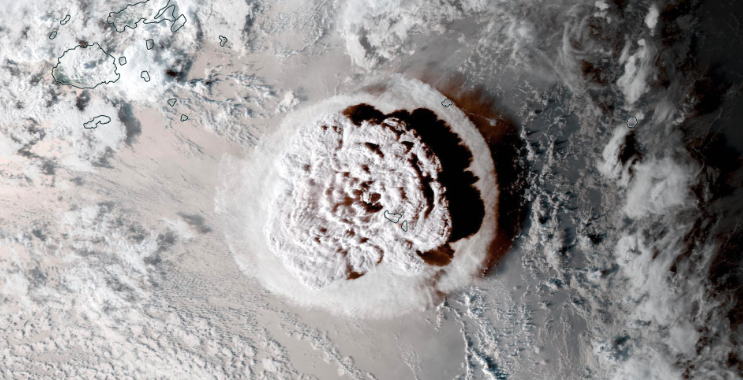
When Tonga’s underwater Hunga Tonga volcano lost its temper in an eruption on January 15, 2022, it belched gobs of magma and exhaled clouds of ash and water vapor out of the ocean, triggering intense lightning. This was no ordinary thunderstorm.
Hunga is infamous for its tantrums, but it has outdone itself. That storm now boasts the most lightning ever recorded on Earth. Hanging ominously above the Pacific Ocean was a volcanic cloud lit by concentric rings of lightning that flashed about 192,000 times over the 11 hours that the volcano was active (that’s some 2,615 flashes a minute). Lightning shot up to 30 km (19 miles) high—another record, beating even cyclones and supercells.
Led by volcanologist Alexa Van Eaton of the US Geological Survey, a team of researchers who took a closer look at the observations from the Hunga eruption and ensuing storm found that no one has ever recorded lightning so extreme. “Our findings show that a sufficiently powerful volcanic plume can create its own weather system, sustaining the conditions for electrical activity at heights and rates not previously observed,” Van Eaton and her team said in a study recently published in Geophysical Research Letters.
Making lightning
Lightning is generated by particles with positive or negative charges that are formed in turbulent air. For a while, air will act as an insulator, and keep these particles from neutralizing each other. But if enough charge builds up, it can cause a breakdown of that air, allowing for electricity to travel so that opposite charges can meet. Their meeting point can be on Earth or where opposite charges have gathered inside a thundercloud.
The concentric rings of lightning seen in the upper atmosphere during the Hunga eruption are thought to have been created by superfast energetic waves known as gravity waves. As these passed through clouds above the volcano, they caused changes in air pressure and brought on enough turbulence to generate lightning.
Though the Hunga volcano actually began to erupt on December 19, 2021, it was at its most temperamental on January 15, when a volcanic plume exploded about 58 km (36 mi) into the sky. There were two geostationary satellites, NOAA’s GOES-8 (using its Geostationary Lightning Mapper or GLM) and the Japan Meteorological Agency’s Himawari-8, which watched the phenomenon as it evolved. It was through this data that the researchers identified four phases of the eruption.
Going through phases
During the first phase, the satellites spotted the volcanic plume rising and falling, but there was no sign of lightning. The second phase was the most powerful. Magma, water vapor, and other volcanic gasses shot through the air at incredibly high velocities, erupting past the mesosphere, where the plume previously topped out, and into the stratosphere, where it reached its maximum height. This created an enormous umbrella cloud in the stratosphere and a smaller cloud slightly below it in the tropopause. The upper cloud is thought to have been as tall as 40 km (almost 25 miles). There was so much mass ejected into the air that it sent gravity waves whooshing at speeds of over 80 meters per second, forming ripples in the clouds, mostly the upper cloud, and expanding the rings of lightning.
The GLM instrument saw the most lightning when the upper umbrella cloud began to move away from the volcano and revealed its smoking vent. Both the eruption and lightning then calmed down slightly, but increased again in the third phase, and it was only in the fourth phase that the intensity began to fade.
Unfortunately, as the plume skyrocketed further than 30 km (about 19 mi) above sea level, GLM had trouble observing it, and the lightning became undetectable at times. Van Eaton and her team think that this was caused by lightning flashing either too low or too high for the satellite to pick up (it is more likely that it was too low because it should have been visible at higher altitudes).
“This event continues to push the boundaries of our understanding of how explosive volcanism impacts the broader Earth system,” Van Eaton said in the study.
Because she and her team found that eruptions can intensify lightning, their discovery will make it easier to assess risks to aircraft from lightning and the ash clouds that can obscure vision. She plans to continue studying this phenomenon for more insight. Sometimes, special effects in nature can seem more unreal than even those in the movies.
Geophysical Research Letters, 2023. DOI: https://doi.org/10.1029/2022GL102341 (About DOIs).
Elizabeth Rayne is a creature who writes. Her work has appeared on SYFY WIRE, Space.com, Live Science, Grunge, Den of Geek, and Forbidden Futures. When not writing, she is either shapeshifting, drawing, or cosplaying as a character nobody has ever heard of. Follow her on Twitter @quothravenrayne.








